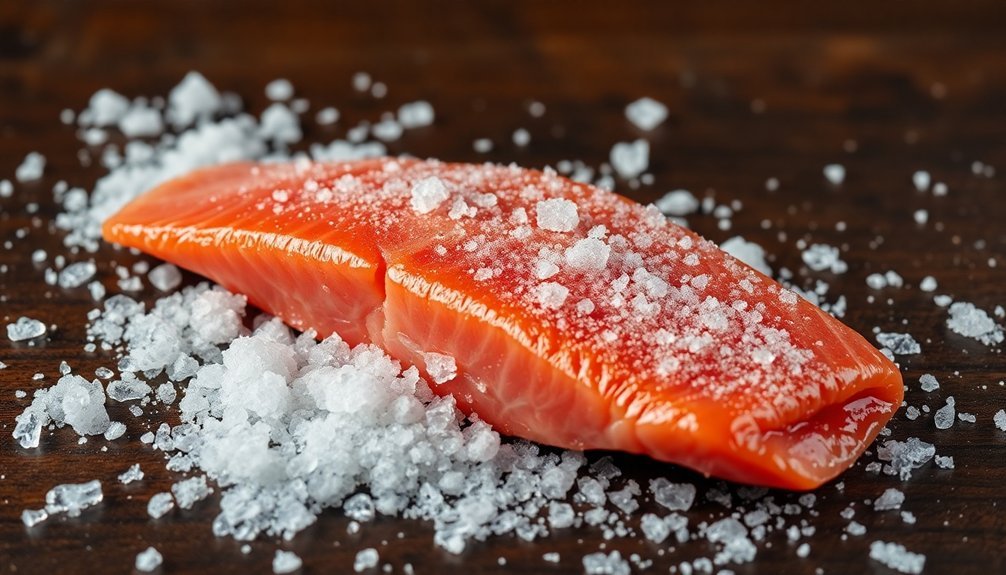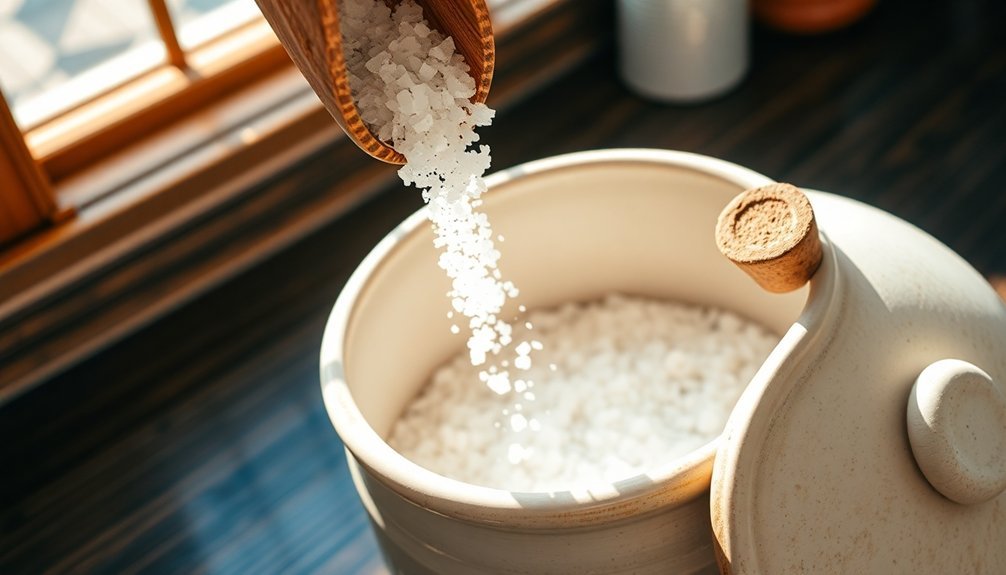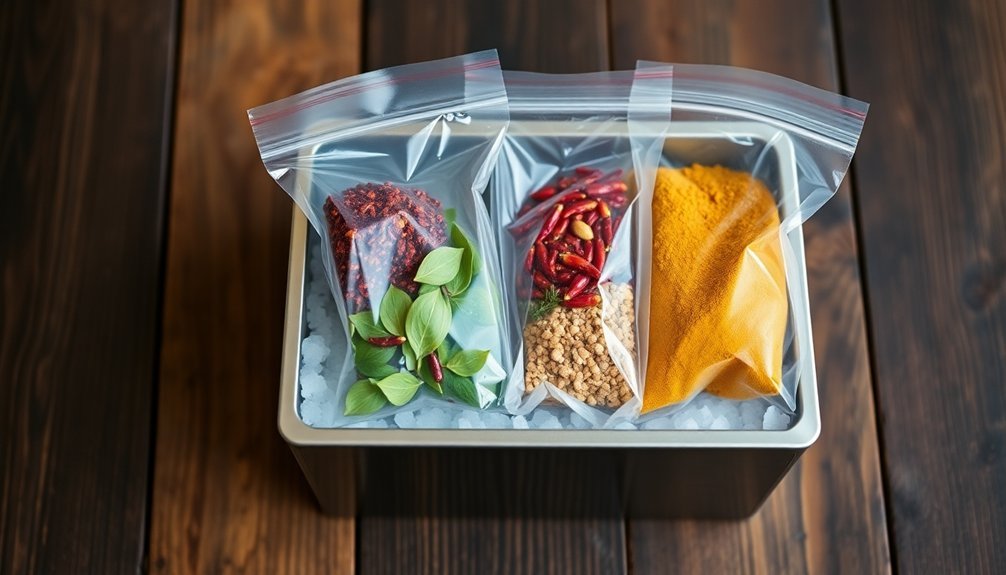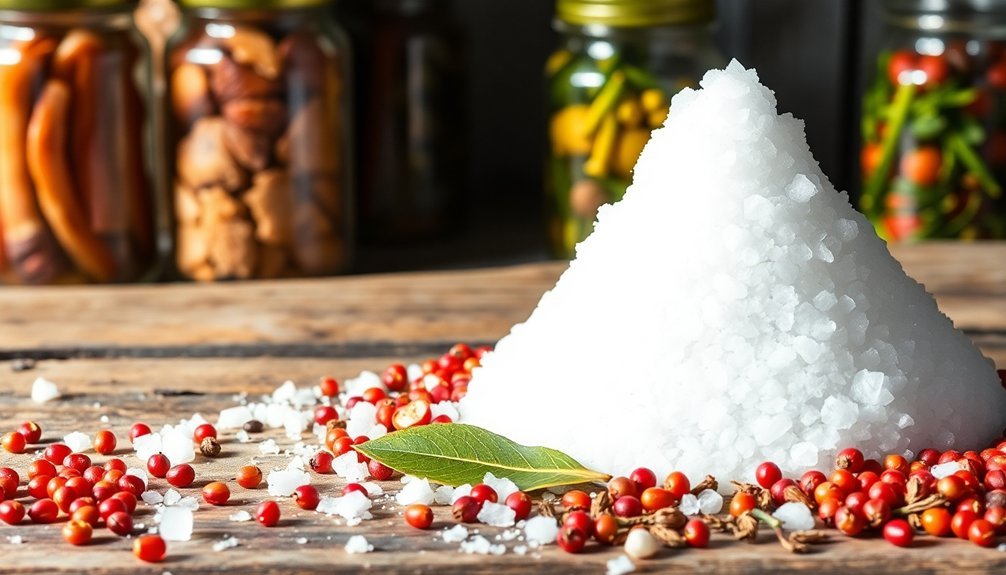Salt boxes keep food fresh for years because they create a hypertonic environment that draws moisture out of both food and harmful microorganisms. When you store food in a proper salt box, the salt's osmotic pressure dehydrates bacterial cells and ruptures their cell walls, preventing growth and spoilage. You'll need the right concentration (about 1 tablespoon per 3/4 lb of food) and proper storage conditions (below 70°F with humidity under 70%) for best results. From meats and fish to vegetables and dairy products, salt preservation remains one of humanity's most effective and time-tested food storage methods. Understanding the full process will help you master this ancient preservation technique.
The Science Behind Salt Preservation

The fascinating science behind salt preservation involves a simple yet powerful process called osmosis. When you apply salt to food, it creates a hypertonic environment that draws moisture out of both the food and any present microorganisms. This moisture reduction is vital because bacteria, molds, and yeasts need water to survive and multiply.
You'll find that salt's preservative power works in two key ways. First, it pulls water from food through osmotic pressure, creating an environment where harmful microbes can't thrive. Sea salt and minerals contribute to enhanced preservation quality.
Second, when salt comes in contact with bacterial cells, it forcefully draws water out of them, effectively dehydrating and killing these microorganisms. The salt crystals actually create such a strong osmotic pressure difference that they can rupture bacterial cell walls.
What makes this process so effective is that salt doesn't just kill existing bacteria – it prevents new ones from growing. By maintaining low water activity levels in food, salt creates an inhospitable environment for microbial growth.
This is why you'll see salt used extensively in traditional preservation methods like curing meats and pickling vegetables.
Ancient Origins of Salt Storage
Civilizations across the globe recognized salt's preservative power as early as 6000 BC, leading to sophisticated extraction and storage methods. You'll find evidence of this in ancient China, where people first extracted salt from natural springs, and in Britain's Yorkshire region, where Neolithic salt pans date back to 3766 BCE.
You'd be surprised to learn how diverse salt extraction methods were in ancient times. While some civilizations relied on solar evaporation of seawater, others developed specialized techniques like open pan production using ceramic, lead, or iron vessels. The Via Salaria in Rome was specifically built to transport salt across the empire.
In regions where seawater wasn't accessible, people extracted salt from plant ashes, including Sago palms and banana trees.
The way ancient civilizations stored salt was closely tied to its immense value – it was often worth its weight in gold. You'll find evidence of this in places like Ethiopia, where people stored salt in block form called "amoleh," serving both as currency and a preservation tool.
In ancient Egypt, you'd discover specially designed storage facilities that kept salt dry for mummification processes and food preservation. These early storage solutions laid the groundwork for modern salt box designs we use today.
Setting Up Your Salt Box

Setting up your salt box requires careful attention to three key elements that'll make or break your food preservation efforts.
You'll need a moisture-tight yet well-ventilated container that allows for proper brine drainage, the right concentration of coarse-grained salt (about one tablespoon per 3/4-pound of food), and a cool storage environment below 8°C with humidity under 70%. Applying food-safe shellac to the interior surfaces helps maintain cleanliness and prevents contamination of stored items.
These fundamental conditions work together to create an effective preservation system that draws out moisture from your food while preventing bacterial growth.
Building The Perfect Box
Building your perfect salt box starts with selecting the right materials and design elements. You'll want to choose durable, food-safe woods like bamboo, olivewood, acacia, or cherry. The material should resist moisture while maintaining the quality of your seasonings.
When designing your box, focus on features that maximize functionality. Include a well-fitted lid that opens fully but acts as a stop to minimize airflow. You'll need enough space to fit your hand comfortably while accessing the contents. Consider adding multiple compartments if you're storing different types of salts or seasonings.
The construction should incorporate secure joints, such as mitered dovetails and stopped dadoes, to guarantee longevity. Treat the interior with food-safe finishes like shellac to protect both the wood and your seasonings. You might want to add practical elements like a matching spoon or magnetic closure for convenience.
Your salt box can serve multiple purposes beyond salt storage. It's perfect for organizing spices, herbs, or even non-food items.
Correct Salt Concentration Matters
Once you've built your perfect salt box, understanding the right salt concentration becomes your next essential step for successful food preservation. You'll need to maintain a concentration above 10% salt to effectively inhibit bacterial growth, but finding the perfect balance is vital since too much salt can make food inedible while too little won't preserve it.
| Salt Level | What Happens |
|---|---|
| Below 10% | Insufficient preservation, bacterial growth likely |
| 10-15% | Ideal for most foods, good preservation balance |
| 15-20% | Strong preservation, may affect taste |
| Above 20% | Maximum preservation, but often too salty to eat |
The preservation process works through osmosis, where salt draws moisture from both food and bacterial cells. This dehydration creates an environment where harmful microorganisms can't survive. You'll want to use coarse-grained salt, like kosher or sea salt, as it dissolves more slowly and penetrates food more effectively.
Remember that different foods require different salt concentrations, and you'll need to adjust based on what you're preserving. Keep your preserved items tightly packed and fully submerged in the salt box, using weights if necessary to maintain proper coverage.
Ideal Environmental Storage Conditions
Your salt box's success hinges on creating ideal environmental storage conditions.
You'll need to focus on both the container choice and storage location to maintain your salt's quality and effectiveness. Choose ceramic or glass containers with plastic lids, as they provide the best protection against moisture and contamination. Don't use metal containers since salt's corrosive properties will damage them, and avoid cardboard boxes that let in air and odors.
Store your salt box in a cool, dry place away from direct light, especially if you're using iodized salt. Select high locations that aren't prone to flooding or moisture accumulation, and keep the container away from your cooking area where steam and food odors can affect the salt's quality.
You'll want to maintain a stable environment that's free from temperature fluctuations and humidity.
For practical storage, consider breaking down bulk salt into smaller, airtight containers like quart-size canning jars. Label each container clearly, and don't use oxygen absorbers in your storage setup.
If you're storing larger quantities, a food-grade 5-gallon plastic bucket can serve as an effective storage solution.
Best Foods for Salt Storage
You'll find that meats and fish are among the most reliable foods for salt storage, with options ranging from bacon and jerky to salt-cured fish.
Salt preservation works exceptionally well for vegetables too, letting you store everything from pickled cucumbers to fermented cabbage in your salt box.
While most people think mainly of meats and vegetables, don't overlook dairy products like salted butter and brined cheeses, which can maintain their quality for extended periods when properly preserved.
Meats and Fish Preservation
Meat and fish stand out as prime candidates for salt preservation due to their high protein content and susceptibility to spoilage. You'll find that both dry curing and brining methods effectively preserve these proteins by drawing out moisture through osmosis and creating an environment where bacteria can't thrive.
When you're preserving meat, you can choose between traditional dry curing or brining. For dry curing, you'll need to apply a thin layer of salt to the meat and store it below 60 degrees Fahrenheit. If you prefer brining, you'll submerge the meat in a concentrated saltwater solution. Both methods will effectively dehydrate bacterial cells and alter protein structures to prevent spoilage.
You'll get the best results using unrefined salts like Himalayan pink salt, Celtic Sea Salt, or Redmond's Real Salt. These mineral-rich options aren't just effective preservatives – they'll enhance the flavor of your preserved meats.
When stored properly in dry conditions, your salted meats can last for years. Salted fish like klippfisk will keep for at least two years if you store it in a cool, dark place. Just remember to rinse the meat thoroughly before cooking to remove excess salt.
Vegetables and Dairy Storage
Preserving vegetables and dairy products through salt storage offers reliable solutions for long-term food storage. You'll find that saltwater soaking effectively kills bacteria and fungi on berries, leafy greens, cucumbers, and tomatoes. Simply mix one tablespoon of salt per gallon of water and soak your produce for 5-10 minutes.
For longer preservation, you can pickle vegetables using a brine solution of 2-3 tablespoons of salt per quart of water. Once fermented and refrigerated, these vegetables will keep fresh for months.
When dehydrating vegetables, sprinkle salt lightly before the process to remove excess moisture and prevent mold growth.
Your dairy products will also benefit greatly from salt preservation. You can extend cheese's shelf life through proper salting during the making process, while butter stays fresh longer when packed in a salt tub.
For yogurt and curds, mixing in salt helps maintain texture and prevents spoilage. Store your salted dairy products in airtight containers in a cool, dry place, and you'll notice they're more resistant to spoilage than their unsalted counterparts.
Root vegetables like carrots and turnips can be stored by lightly sprinkling them with salt and keeping them in a cool, dark area.
Temperature and Environmental Requirements

Maintaining proper environmental conditions is essential for salt boxes to effectively preserve food. You'll need to keep your salt storage area at temperatures below 70°F (21°C), as excessive heat can degrade both the salt and your preserved foods.
While freezing won't make your food unsafe, it can affect its texture, so avoid areas that reach freezing temperatures.
Your storage location should be dark and well-ventilated, away from direct sunlight and steam-prone areas like kitchens. Basements or dedicated storage rooms often provide the ideal environment, as long as they maintain consistent temperatures.
You'll want to avoid areas that experience temperature fluctuations, which can lead to moisture problems.
Humidity control is particularly important since salt readily absorbs water from the air. Keep relative humidity below 74% to prevent salt from dissolving and losing its preservative properties.
You can protect your salt by using airtight containers with secure lids – plastic containers work especially well for this purpose.
Don't use oxygen absorbers with salt, as they're unnecessary and can cause problems. If you're storing bulk salt, consider repackaging it into smaller, airtight containers to maintain its effectiveness.
Common Salt Box Storage Mistakes
When storing salt in boxes, people often make several significant mistakes that can compromise their food preservation efforts. The most common error is choosing inappropriate containers – cardboard allows moisture penetration, plastic can leach chemicals, and metal containers rust due to salt's corrosive properties. You'll want to avoid these materials and guarantee you're using properly sealed, food-grade containers.
Another important mistake isn't accounting for moisture control. If you're storing your salt box in humid environments like kitchens or basements, you're setting yourself up for failure. The salt will absorb moisture from the air, leading to clumping and reduced effectiveness. You should also add desiccants like uncooked rice to help absorb excess moisture.
Poor storage practices can also derail your preservation efforts. Don't store salt near strong-smelling items, as it'll absorb those odors. You'll need to label and date your containers, use clean equipment, and perform regular checks for contamination.
Additionally, many people overlook salt's hygroscopic nature and natural deodorizing properties. Remember that iodized salt has a limited shelf life, and hot storage environments can increase humidity levels, leading to clumping.
Modern Applications of Salt Boxes

Today's salt boxes serve far more purposes than their historical counterparts, extending beyond basic food preservation into modern culinary and industrial applications.
You'll find salt boxes increasingly used in commercial kitchens and food processing facilities, where they're integrated with modern preservation techniques. They're particularly valuable in artisanal food production, where you can use them to cure meats, preserve vegetables, and create specialty food products.
Many ready-to-eat meal manufacturers have also adapted salt box principles for their production lines.
In areas with limited access to refrigeration, you can still rely on salt boxes as a primary preservation method. They're especially useful when combined with other preservation techniques – you might use a salt box alongside refrigeration or vacuum sealing for ideal results.
For home use, you'll want to choose a box with proper humidity control and temperature monitoring capabilities.
To maximize your salt box's effectiveness, you should use coarse-grained salt like kosher or sea salt, maintain consistent temperature conditions, and regularly check your preserved items.
Don't forget to label and date everything you store, and keep your salt box in a cool, dry location to guarantee the best preservation results.
Frequently Asked Questions
Can Salt Boxes Be Reused for Different Types of Food?
Yes, you can reuse salt boxes for different foods if you clean them properly and guarantee they're completely dry. Just make sure there's no moisture, residual flavors, or odors before switching to new contents.
What Materials Are Best for Making a Salt Box?
You'll find glass and stainless steel are the best materials for salt boxes. They're non-reactive, easy to clean, and provide airtight storage. Ceramic's also great if you want better breathability for your salt.
How Does Altitude Affect Salt Preservation in Storage Boxes?
You'll find that altitude mainly affects salt storage through humidity and pressure changes. While higher altitudes often have lower humidity, you'll still need airtight containers to prevent moisture absorption and maintain salt's preservative qualities.
Are There Alternatives to Regular Salt for Preservation in Boxes?
You can use citric acid or potassium chloride-based substitutes for preservation in boxes, but they're less effective than regular salt. Herbamare sodium-free works well for flavor but won't preserve as long.
Can Electromagnetic Fields Impact the Effectiveness of Salt Box Storage?
You don't need to worry about electromagnetic fields affecting your salt box storage. EMFs won't impact the preservation process since they don't interfere with salt's ability to draw moisture from food or kill bacteria.
In Summary
You'll find salt box storage remains one of the most reliable preservation methods available today. Whether you're storing meat, fish, or vegetables, this ancient technique still works perfectly in modern kitchens. By following proper temperature controls and avoiding common mistakes, you can successfully preserve food for years. Don't overlook this time-tested method – your properly maintained salt box will serve you well in your food preservation journey.





Leave a Reply